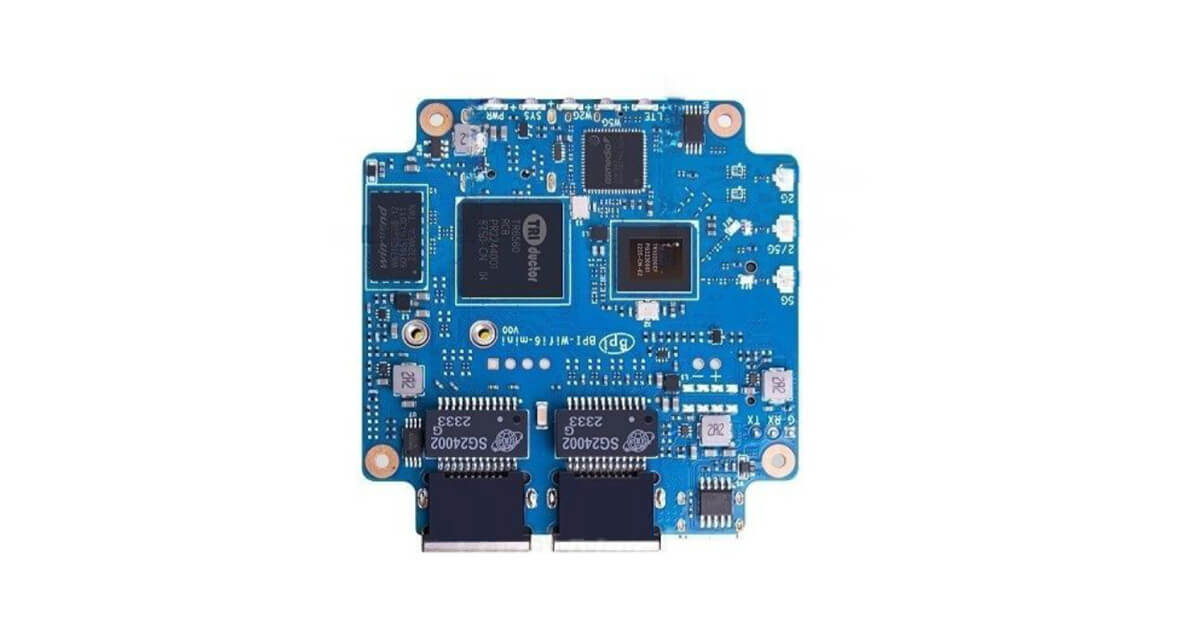Part II: Banana Pi BPI-WiFi6 Mini Review
Let’s take a deeper dive into the hardware of the Banana-Pi-BPI WiFi6 Mini board.
The WiFi 6 Mini hardware platform is based on the Triductor Technology System on Chip (SoC) solution. The TR6560 chip is based on a multicore processor architecture, typically featuring a combination of ARM Cortex A9 cores that deliver a balance between performance and power efficiency.
The Triductor SoC is widely applicable to a variety of cutting-edge technologies, including Smart Home Devices, IoT Solutions, and Networking Equipment. One key advantage of this remarkable hardware lies in its exceptional affordability, as it is unmatched in its cost-effectiveness, priced at a very accessible price of $31.
How do the hardware specifications of the new model compare to its predecessor?
Although the specifications may differ from the previous R3 Mini board, the hardware specs of the board are categorized in the low-level segment. What does this mean from a user standpoint? For users who do not require a 2.5GbE connection, a pair of 1GbE LAN ports will meet most needs.
This suggests that the board’s hardware is primarily designed for basic functionality and may not have the capacity to support advanced features or high-speed connections beyond the 1GbE bandwidth range. Everyday users or individuals with standard networking requirements will find the 1GbE LAN ports suitable for their daily needs, including fiber internet infrastructure. However, for a more detailed comparison between the two Single Board Computers (SBCs), please refer to the table provided below.
What about storage space?
When comparing the WiFi 6 Mini to the higher-cost R3 Mini board, one notable difference is the absence of an M.2 Key B slot in the former. This implies that adding an NVMe card is not an option. Furthermore, similar to the R3 Mini variant, the WiFi 6 Mini does not have a Micro SD Card socket, so if you need additional storage capacity, it is worth considering investing in an external HDD as a feasible alternative. Nevertheless, if having the NVMe option is an essential requirement for building a compact mini server, then the R3 Mini emerges as the superior choice among the two models.
What is the reason behind the limited memory on the Banana Pi BPI-WiFi 6 Mini?
A limited RAM capacity can greatly limit the capabilities of certain users. However, the specially designed board functions as a mesh/router/AP device, providing a highly cost-effective and optimized solution. Surprisingly, despite having only 128Mb of available RAM, this limitation might not be as substantial as one would assume. Sinovoip, the company behind Banana Pi products, has confirmed with us that their device can be utilized as a mesh device by wirelessly connecting multiple devices.
Banana Pi BPI-WiFi6 Mini vs. Banana Pi BPI R3 Mini (Hardware Comparison)
| Feature | Banana Pi BPI-WiFi 6 Mini | Banana Pi BPI-R3 Mini |
|---|---|---|
| SoC | Triductor TR6560 | MediaTek MT7986 (Filogic 830) |
| RAM Configurations | 128 GB (DDR3) | 2 GB (DDR4) |
| CPU Architecture | Cortex-A9 | Cortex-A73 |
| Core Number | 2 | 4 |
| CPU Frequency (Max) | 2x 1.2 GHz | 4x 2.00 GHz |
| Interfaces | 1x M.2 Key B interface | 1x M.2 Key B interface 1x M.2 KEY M interface |
| Micro SD (TF) Card Slot | ❌ | ❌ |
| 8GB eMMC Onboard Storage | ✅ | ✅ |
| 128MB SPI-NAND Flash | ✅ | ✅ |
| Boot Switch | ✅ | ✅ |
| USB Port | 1x USB 3.0 Type-A port | 1x USB 2.0 Type-A port |
| Integrated WiFi | Wi-Fi 6 2×2 2.4G + 2×2 5G | Wi-Fi 6 2×2 2.4G + 3×3 5G |
| Compatible with 4G/5G Modem Modules Cards. (Through the M.2 Key B interface) | ✅ | ✅ |
| 3 Antennas | ✅ | ✅ |
| 3 Pin Debug Serial Port (UART) | ✅ | ✅ |
| Reset Button | ✅ | ✅ |
| Ethernet | 2x 1GbE RJ45 Ethernet | 2x 2.5GbE RJ45 Ethernet |
| Nano SIM | ✅ | ✅ |
| Dimensions | 65×65 mm | 65×65 mm |
| Weight | 100g | 100g |
| Power Interface | 20W/12V,USB Type-C PD | 20W/12V,USB Type-C PD |
| RTC Battery Interface | ❌ | ❌ |
| FAN Socket | ✅ | ✅ |
| OS | Ubuntu/Debian/OpenWrt | Ubuntu/Debian/OpenWrt |
| Estimated Price | Starting at $31 (Bare board) | Starting at $70 (Bare board) |
Banana Pi BPI-WiFi6 Mini











